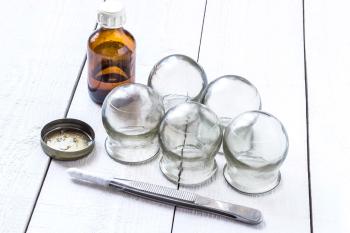Cupping
Planning
STARTDATUM
25-04-2026
25-04-2026
EINDDATUM
25-04-2026
25-04-2026
LOCATIE/VENUE
TIJD
09:00-16:30
09:00-16:30
Inleiding/Introduction
Cupping wordt sinds eeuwen over de gehele wereld toegepast. In de Westerse wereld is cupping in de vergetelheid geraakt door de opkomst van de antibiotica. In de Traditionele Chinese Gezondheidszorg echter is het nog steeds één van de meest gebruikte therapieën.
De behandeling met cupping is simpel, veilig en effectief.
Het toepassingsgebied is uitgebreid. Zowel oppervlakkige aandoeningen (verkoudheid, hoest) als gewrichtsproblemen, sportblessures, respiratoire aandoeningen enz. worden met cupping behandeld.
De cursus gaat dieper in op de verschillende manieren van cupping en op de toepassing bij verschillende aandoeningen.


Where did cupping originate from?
In the Chinese tradition, the evidence of the use of cupping therapy can be traced back to the early Han Dynasty. Ge Hong – a famous herbalist and alchemist during the Jin Dynasty is considered the first to use this technique in China
Cupping is a therapy used in traditional Chinese medicine (TCM) to remove stagnation and stimulate the flow of qi (chi). Qi is the free flow of vital energy circulating through the body and the world around us, if the qi is disrupted or disturbed, it can create stagnation (blockages) or imbalances in the body.
What is Chinese cupping called?
In Chinese, cupping is known as "pulling-up jars" (Chinese: 拔罐; pinyin: báguàn). According to traditional Chinese medicine (TCM), cupping is done to dispel stagnation (stagnant blood and lymph), thereby improving qi flow.
Inhoud/Content
-
Het heilzame effect van cupping (huid, lymfesysteem, Qi, bloed, WEI Qi, zenuwstelsel)
-
Indicaties
-
Voorzorgen en contra-indicaties
-
Voorbereiding van de patiënt
-
Procedure
-
Tonifiëren en draineren d.m.v. cupping
-
Cupping bij kinderen en volwassenen
-
Specifieke toepassingen bij vertebrale blokkades, lage rugklachten (visceraal en psychosomatisch)
-
Cupping op triggerpunten
-
Cupping bij sportblessures (verzwikte enkel, zweepslag, hielspoor)

Doelstellingen/Objectives
-
De opleiding is gericht op het aanleren van technische & exact-wetenschappelijke kennis en is van toepassing zoals bepaald binnen de Zorg STEM-opleidingen
- De opleiding is gericht op het aanleren van technische kennis en & exact-wetenschappelijke kennis en de toepassing ervan in het Postgraduaat Acupunctuur en in Postgraduaat Chinese Gezondheidszorg, Hoger Onderwijs, gepubliceerd op onderwijskiezer.be en/of als bijscholing hiervan
- Belangrijk
- deze opleiding maakt deel uit van het 1e jaar Postgraduaat Chinese Gezondheidszorg.
- De cursus is vooral praktijkgericht. De nadruk ligt op het inoefenen van de verschillende technieken met wat uitbreiding op de basis.
-
de combinatie van specifieke cupping-acupunctuur-technieken, worden tijdens de opleiding Postgraduaat Acupunctuur gedoceerd.
Toelatingsvoorwaarden/conditions of admission
-
Acupuncturisten of nog in opleiding (PGAC 2 en PGAC3) bij ICZO vzw
-
TUINA Therapeuten
-
Therapeut Chinese Gezondheidszorg of nog in opleiding (PGCG 2 & PGCG 3) bij ICZO vzw
Datum/Data
- zaterdag 25 april 2026
Lesuren/Timing
- 09.00 - 16.30 uur
Docent

Heyte Lieselotte
- Verpleegkundige
- Acupuncturist
Accreditaties/Accreditation
Het aantal accreditatiepunten verschilt per beroepsverenging en wordt best nagezien bij de betreffende organisatie
LVNT, NWP
Studiepunten/Credits
0.5 = Een studiepunt is een binnen de Vlaamse Gemeenschap aanvaarde internationale eenheid die overeenstemt met ten minste 25 en ten hoogste 30 uren voorgeschreven onderwijs-, leer- en examenactiviteiten en waarmee de studiebelasting van elke opleiding of elk opleidingsonderdeel wordt uitgedrukt
Cursusgeld/Fee
210 €
KMO-P
Kom je in aanmerking? zie https://www.iczo.be/nl/kmo-portefeuille
Voertaal/Language
Nederlands
Cursusmateriaal/Hand-outs
De Syllabus wordt via het ICZO-platform aangereikt na betaling van het cursusgeld. Hiervoor wordt de cursist tijdig uitgenodigd (binnen de week voor de 1e lesdag)
Diversen/Miscellaneous
-
Aantal cursisten: max 10 wegens de uitgebreide praktijkoefeningen
-
Benodigdheden: losse praktijkkledij
-
Doorlopende coffee breaks (koffie, thee, water) + broodjeslunch (broodjes, soep, saladebar, koffie, thee en water, ....)
-
Gratis ondergrondse parking voor Uw wagen
-
De organisatie behoudt zich het recht voor om eventuele wijzigingen in het programma en planning aan te brengen.
Therapeutenlijst
Testimonials
-
Van Roosbroeck Nicky : zeer deskundige uitleg,
-
Laceur Patrick : sterk punt = combinatie theorie en praktijk.
-
Van Tongelen Marleen : Zeer praktisch
-
Cops Nele :Goede afwisseling tussen praktijk en oefening Ook fijn dat we mochten oefenen met verschillende cups
-
Vissers van Scie Yvonne : veel praktijk ervaring opgedaan
-
Rogiers Jasmien : Heeel goeie, duidelijke docente!
-
Dr. Hulsbergen Helene : Prima dag, ruimte voor vragen/ een op een momenten met de docenten waren ruim aanwezig. relaxte sfeer, fijne docenten!! Het eten was goed verzorgd, heerlijk!!
-
Enkhsaihan Horolsuren :interactieve boeiende cursus, voldoende oefenmomenten, de dag was snel voorbij
-
Derison Kristel : Goede interactie tussen docent-cursisten, goede uitleg, docent geeft duidelijke informatie, ook praktijkgericht. Heel praktisch ingestelde cursus, dadelijk toepasbaar in de praktijk
